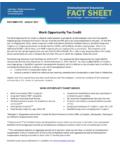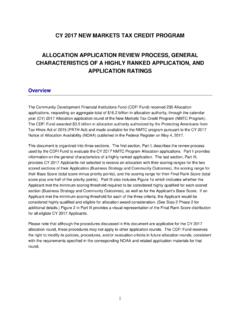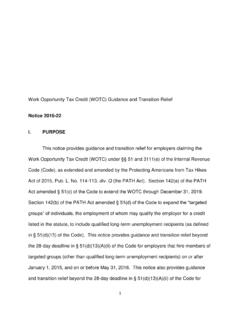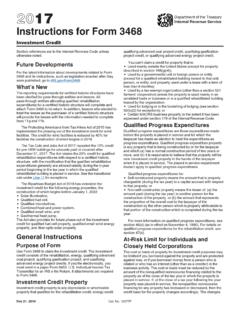Transcription of BY RICH SHAVELL Converting from a C to an S …
1 Copyright 2017 by the Construction Financial Management Association (CFMA). All rights reserved. This article first appeared in CFMA Building Profits (a member-only benefit) and is reprinted with permission. BY RICH SHAVELL . Converting from a C to an S Corporation? Beware the Built-in Gains Tax To avoid double taxation, a C corporation may consider con- Although the details are beyond the scope of this article, verting to an S corporation. However, when the fair value of other complexities must be considered. For example, the an entity's assets at the relevant date of conversion is more former C corporation could have certain unused beneficial tax than its tax basis, a C corporation may incur the built-in attributes carrying over, such as unused net operating losses gains tax,1 which applies to certain assets that have appreci- (NOLs), capital loss carryovers, general business tax credits, ated or are converted to cash after a C corporation changes and certain other tax to an S However, not all attributes can be used.
2 Unused charitable This extra tax can surprise Converting businesses, espe- contributions and foreign tax credits cannot be carried cially contractors that use a more favorable revenue rec- Further, each of these attributes have specific carryover ognition method for tax purposes, such as the cash basis periods. For example, unused NOLs can currently be car- or completed-contract method (CCM). Let's look at the ried forward 20 years,7 whereas others may have a shorter nuances that affect the built-in gains tax. carryover period. Impact of Deferred Income & Other In addition, not only are there built-in gains, but there can Attributes also be built-in losses to offset the built-in Valuation The unrecognized built-in gains at the time of conversion of the entity's assets (and deferred taxable income) at the is not just the unrecognized gain on the sale of appreciated time of conversion is critical.
3 Assets. The built-in gains tax is also impacted by deferred income. Percentage-of-completion Deferred Income Example earnings at date of conversion (portion of the unrecognized built-in Let's assume that a contractor converted from C corpora- gain at time of conversion) $1,000,000. tion to S corporation status during 2016. At the time of conversion, the contractor has four contracts in progress, on Earnings actually reported for tax purposes as of date of conversion 0. which $1 million of gross profit would be recognized if the percentage-of-completion method (PCM) had been used.
4 Built-in gains subject to tax 1,000,000. Built-in gains tax rate However, the contractor qualifies for exemption from IRC (highest corporate rate) x 35%. 460 under the small contractor's exemption and uses the The calculation at right shows what taxes would be Built-in gains tax at the corporate level $350,000. due if all four contracts were completed during Earnings passed through to the S. corporation owners ($1,000,000 less The S corporation and its shareholders pay $607,400 of total $350,000 built-in gains tax) $650,000. tax: $350,000 at the corporate level and another $257,400.
5 At the shareholder level. This represents an effective rate of Personal tax rate (maximum more than 57% on the $1 million of unrecognized contract personal rate assumed) x profits as of the date of conversion to S corporation status. Personal tax paid by the S. The effective rate may be even higher if state income taxes corporation owners $257,400. are applicable. CFMA Building Profits May/June 2017. tax TECHNIQUES. Recognition Period deferral for example, where net billings-in-excess is greater Under the protecting Americans from Tax hikes Act 9 than net costs-in-excess.
6 (PATH Act), the built-in gains tax can apply for up to five years after conversion to an S corporation. That is, for each Before Converting from a C corporation to an S corporation, of the five years after a corporation elects S status, it is pos- the CFM must know what to include in the computation of net unrecognized built-in gains and when the various defer- sible that the tax could apply when built-in gain property is rals could result in corporate-level income tax. sold or deferred taxable income is recognized. Valuation Issues For example, let's say that an entity that was previously a If the entity has a built-in gain, then it should track its dis- C corporation owns real estate that has appreciated and a positions over the next five years.
7 Upon sale of their assets, favorable offer arrives in year four. The taxpayer should con- taxpayers need to be able to document which amounts sider whether the property should be sold now or after the are built-in gains and which amounts are appreciation that statutory fifth year passes to avoid double taxation. occurred after the date of conversion. As demonstrated in the previous calculation, the combined For example, let's say that a property was purchased 15. tax could be sizable; but it may not make sense to wait years before the C corporation converted to an S corpora- another year if a favorable offering price no longer exists.
8 Or, tion. The asset was valued at $150 at purchase and $175. alternatively, significant tax attributes, such as a carryover at conversion. The asset sold for $325 three years after the of an NOL, could be available; this is unlikely because the conversion date. S corporation election is generally delayed until the favor- able carryovers are consumed. Nonetheless, all facts must In this example, $25 ($175 less $150) of the total gain of $175. be uncovered and understood to make a sensible business ($325 less $150) is taxable as built-in gains. Without an appro- decision.
9 Priate valuation at the time of the conversion, the taxpayer may not be able to defend an IRS auditor's assertion that the Issues for Small Contractors entire gain (or even more) is part of the built-in gains. Smaller contractors can unknowingly face the built-in gains tax. The regulations focus on potential deferrals from when The IRC states that the net unrecognized built-in gain is the the entity is a C corporation as well as when income is being net gain that would have been recognized had a corporation recognized in a later year when the entity is an S corporation.
10 Sold its assets at the beginning of the five-year recognition period for the fair market value in a single transaction to For smaller contractors that use the cash method as a C an unrelated buyer who also assumed the entity's liabilities. corporation (compared to the accrual method), the defer- Other adjustments, such as Section 481(a), can add to the ral of income is considered a net built-in gain that can be subject to the built-in gains Small C corporations are permitted to use the cash method when revenues average All assets are considered when the company's assets are $5 million or valued, including intangibles such as goodwill.





